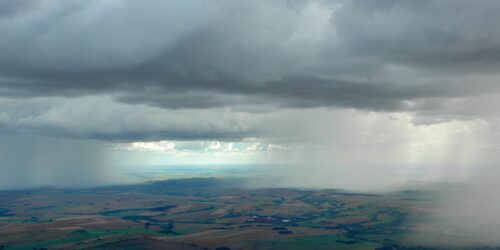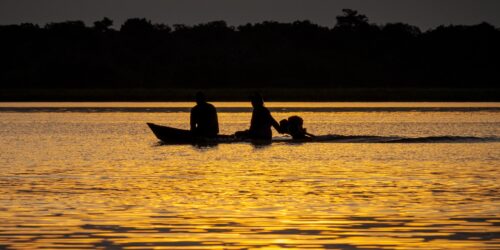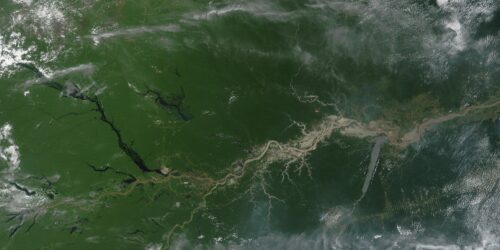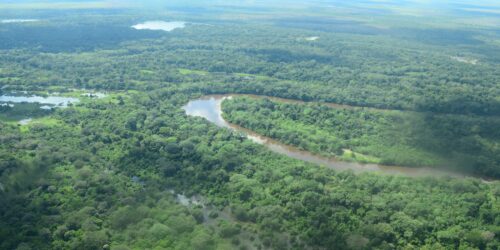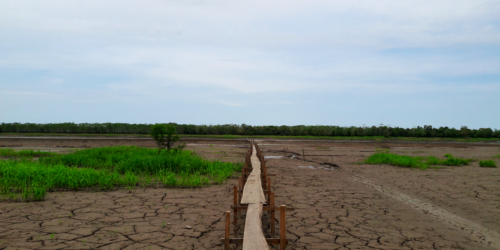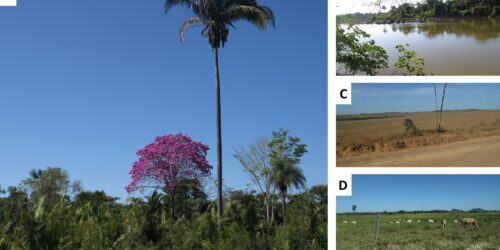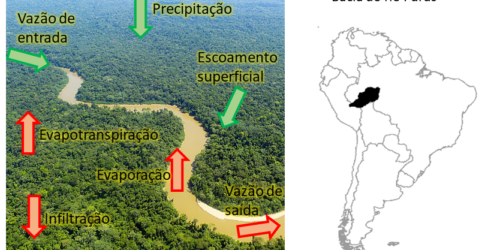Amazon rainfall from space: the case of Roraima state
11 February 2021 | Duration of reading: 8 min
By Larissa de Castro Ribeiro
Rainfall is one of the main hydrological cycle components and is directly responsible for ecosystem maintenance and landscape evolution. Furthermore, rainfall estimation is crucial for water resources management, allowing a satisfactory planning of water use (e.g., public supply, agriculture and energy generation). Therefore, quantifying rainfall is essential to comprehend a variety of processes of the terrestrial dynamics.

Monthly accumulated rainfall for October 2020 (mm/month), estimated by the GPM satellite constellation (GPM_3IMERGM v06) in the Amazon region. Source: Plataforma Giovanni (NASA).
One of the methods commonly utilized to measure rainfall is through field monitoring (in situ) equipment, such as rain gauges (Figure 2). A rain gauge consists of a container that gathers the rainfall over a predefined area and expresses its amount in millimeters, in which each millimeter corresponds to 1 liter of water in an area of 1 m².
However, the in situ monitoring becomes challenging in some regions, such as the Amazon forest, and is insufficient to fully represent the variation of rainfall behavior throughout this huge area. Such limitation is a result of the difficulty to install rain gauges and to maintain them functional in remote areas. In the Brazilian HIDROWEB platform (Link) we can see the network of rain gauges stations maintained by the Brazilian Water Agency (ANA) in the Brazilian territory.

Automatic rain gauge. Source: Danrlei Menezes (IPH/UFRGS).
Given these difficulties, other methodologies were developed to evaluate rainfall through remote sensing, utilizing data generated by satellites in space missions. Some of the most known missions are TRMM (Tropical Rainfall Measuring Mission), which analyses multiple satellites to estimate rainfall, GOES (Geostationary Operational Environmental Satellite), which estimates can easily be observed in INMET page (Link) on the "Satélite" tab, and GPM (The Global Precipitation Measurement).
For example, GPM uses a satellite constellation (illustrated in the image below) to estimate rainfall each 30 minutes for latitudes between 60°N and 60°S, with spatial resolution of 0,1° x 0,1° (i.e., estimates rainfall of an area with approximately 10 km x 10 km).

Satellites and member nations of GPM constellation. Source: NASA.
Os dados de chuva estimados por sensoriamento remoto podem ser obtidos e observados através de sites como a plataforma Giovanni (GES-DISC Interactive Online Visualization ANd aNalysis Infrastructure) da NASA (Link), and then can be analyzed and quantified utilizing geographical information systems (GIS)
In our study "Precipitation estimated by the TRMM satellite in the Brazilian Roraima state”, we evaluated the usage of satellite data through the comparison of remote sensing estimates and data from 36 rain gauges available by ANA, utilizing historical rainfall series of 11 years (2005 to 2015).
In the figure below, we can observe that TRMM underestimated the rainfall in the southwestern region and overestimated it in the northeastern region, when compared to in situ rainfall data. In summary, comparing error magnitudes and correlation of rainfall estimates (more information here), os dados observados pelo satélite apresentaram desempenho satisfatório na representação das precipitações pluviométricas do estado de Roraima.
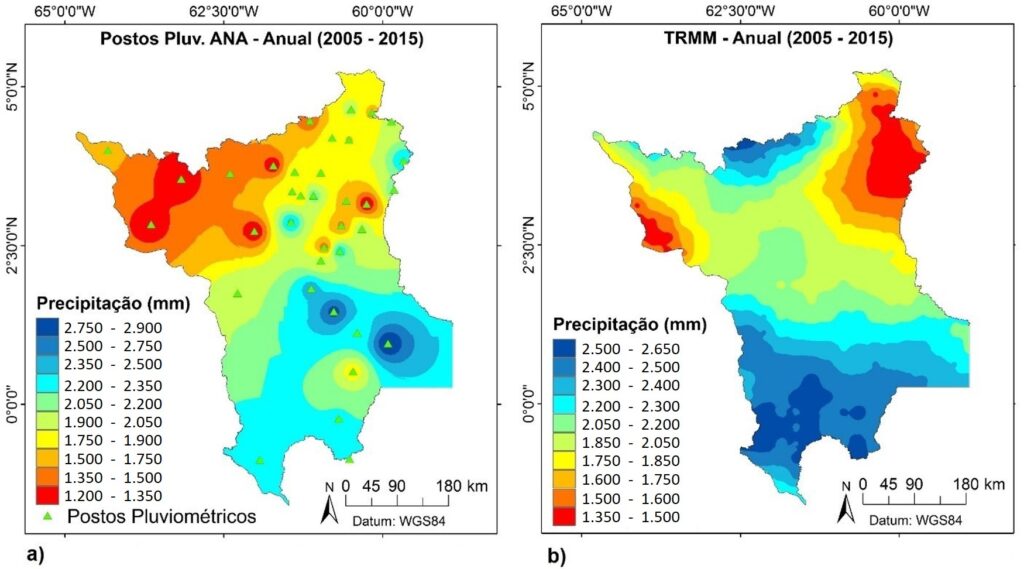
Mean annual rainfall in Roraima state a) obtained from rain gauges and b) estimates from TRMM. Source: Ribeiro et al, 2019.
Studies similar to the presented here show remote sensing techniques as a potential alternative to accurately estimate rainfall, providing data to more refined water availability studies, especially in data scarce regions. However, we emphasize that field measurements, as rain gauges, are fundamental to evaluate, validate and enhance the performance of satellite estimates.
Science is done collaboratively
The text presented is the result of the research carried out by Larissa de Castro Ribeiro for her undergrad thesis. The work was supervised by Dr. Silvestre Lopes da Nobrega and had the financial support of the Brazilian government through CAPES; data were provided by the Brazilian Water Agency (ANA) and the TRMM Mission (NASA and JAXA).
Want to know more? Access the links below!
Ribeiro et al. (2019). Precipitação estimada pelo Satélite TRMM na região do Estado de Roraima. Anais do XIX Simpósio Brasileiro de Sensoriamento Remoto. ISBN: 978-85-17-00097-3. (Link).
Beck et al. (2019). MSWEP V2 Global 3-Hourly 0.1° Precipitation: Methodology and Quantitative Assessment. https://doi.org/10.1175/BAMS-D-17-0138.1. (Link).
Oliveira et al. (2019). Avaliação dos dados de precipitação estimados pelo MSWEP para a bacia Amazônica. Anais do XVIII Simpósio Brasileiro de Sensoriamento Remoto -SBSR ISBN: 978-85-17-00088-1. (Link)
Santos et al. (2018). Validação dos dados de precipitação estimados pelo satélite GPM na região sul do Amazonas. Rev. Ambient. Água [online]. 2019, vol.14, n.1. (Link).
NASA. IMERG: Integrated Multi-satellitE Retrievals for GPM. (Link).
NASA. TRMM – Tropical Rainfall Measuring Mission. (Link)

Larissa de Castro Ribeiro is a civil engineer (UFRR – 2018). She is currently a master's student at the Institute of Hydraulic Research (IPH) – UFRGS, where she studies the characterization of the hydrological regime of the rivers of South America. More details on Lattes.

